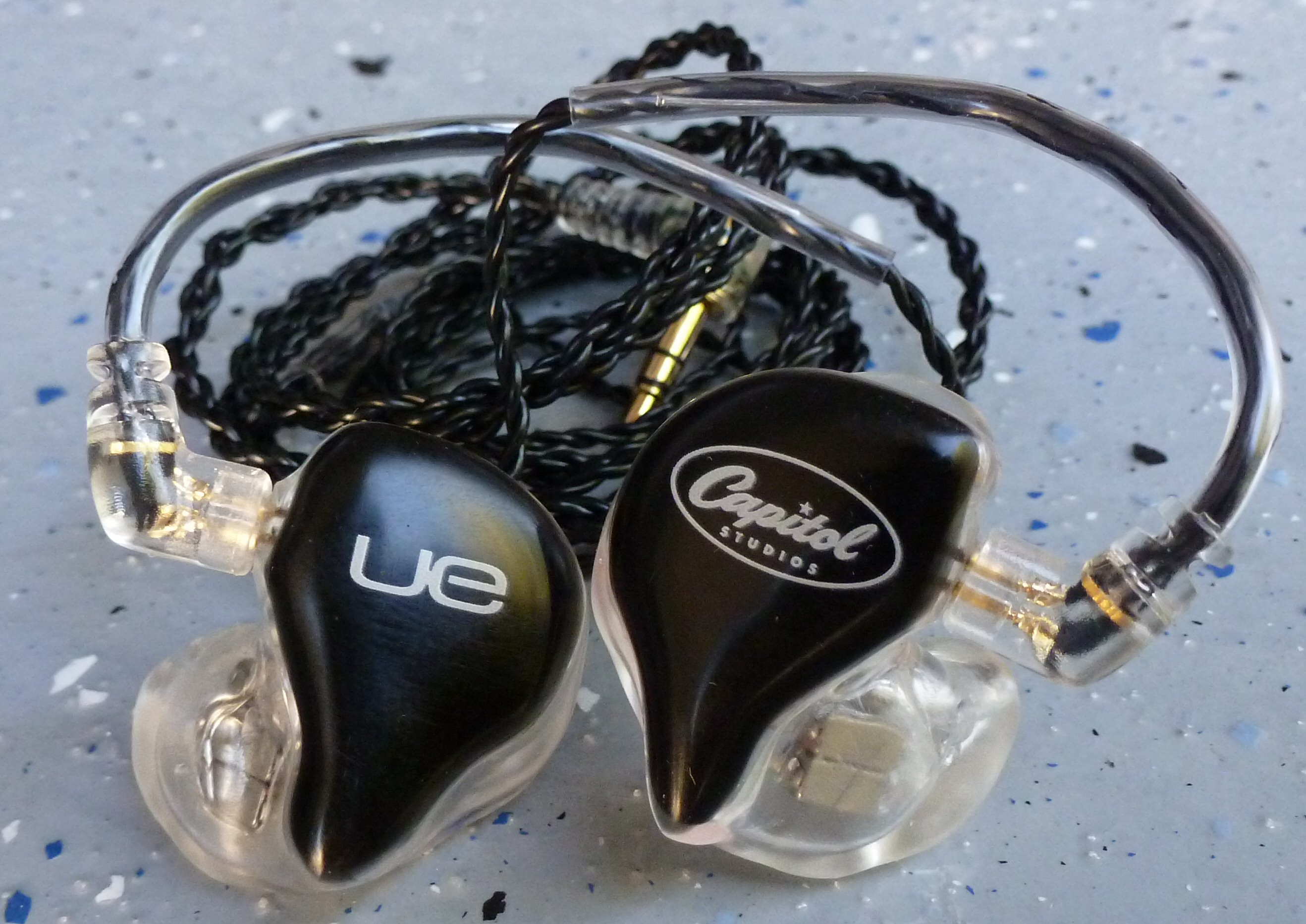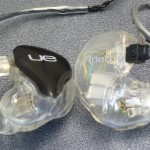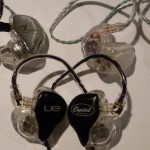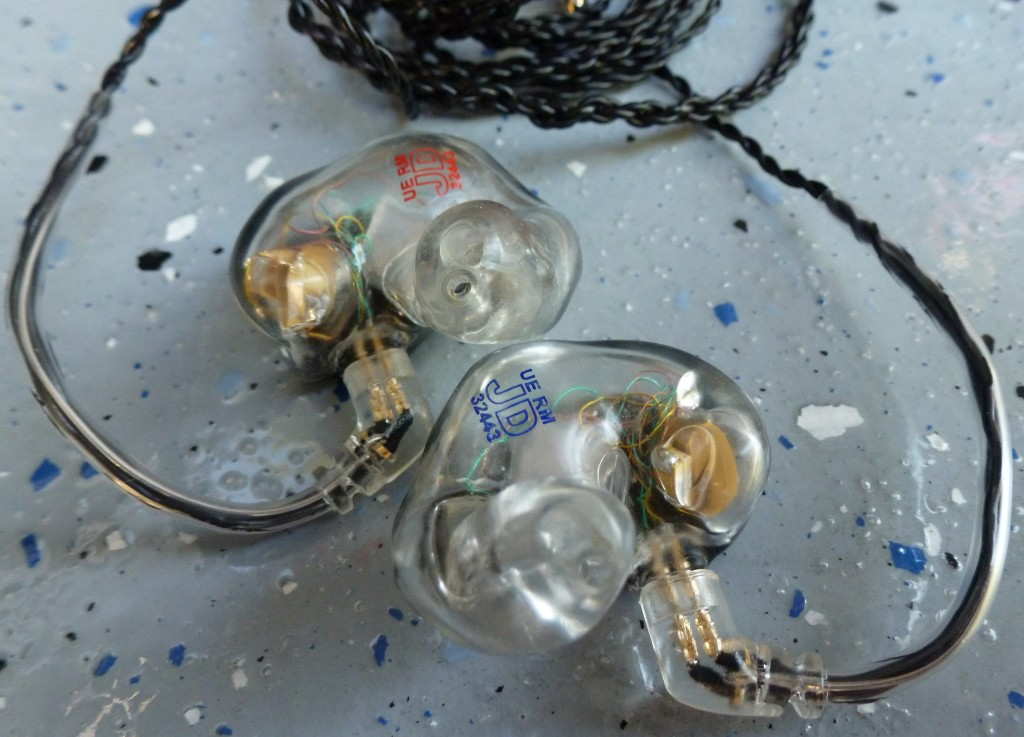COMPARISONS
JH Audio JH16 Pro: Frequency response wise the JH16 has much more bass emphasis and less midrange emphasis resulting in a more U shaped sound in comparison, but also a sound that is fuller than the IERM. They both have a brightness to them however the IERM treble is a bit brighter with a higher peak than the JH16 that is presented more forward and intimate. The comparative difference of the midrange vs. the treble of each is pretty close, but the more forward midrange of the IERM gives a more uniform presentation across the spectrum. While I find the JH16 midrange to be fairly neutral, it sounds a little sucked out in direct comparison with the IERM.
Soundstage of the JH16 is wider but the IERM has better depth and height without giving up too much width. With certain genres such as speed metal and fast trance the JH16 has a sense of speed in comparison to the IERM, and this sense of speed sometimes carries over to genres it shouldn’t such as easy listening where the drums on many EBTG tracks are quick and punchy; not what they intended if you ask me! Both are technically similar overall and even have many similarities in the presentation, but on a professional level the IERM would be a better fit for a recording engineer while I would choose the JH16 for on stage IMO. For music enjoyment, the choice will be dependent on many things primarily revolving around the music you listen to and the quality of that music.
EarSonics EM3 Pro: This comparison is about a thick and rich presentation vs. an analytical and detailed presentation. The IERM sounds bright and laid back in the mids when compared directly with the EM3 Pro. With electronic music the EM3 Pro sounds to mid centric resulting in a sound that seems off in comparison while with other music it is a tossup as to which sounds more “right” to my ears. The thickness of the EM3 Pro often holds it back compared with the clearer IERM but the additional presentation depth and more ambiance of the EM3 Pro can win out to my ears at times. Bass quantity of the EM3 Pro is higher as is overall dynamic range and sub-bass rumble but the IERM has better detail and texture. Overall, details are not just easier to hear with the IERM, but more detail is presented.
Most of the time the IERM has better transparency with a less colored recreation, but in recordings with plenty of ambiance the EM3 Pro can simply disappear even though it still adds color to the frequency response. While these two present music in very different ways, technically the IERM is superior to the EM3 Pro, but it doesn’t really matter since I can’t imagine someone choosing between these two.
Rooth LS8: The first thing I noticed with A/Bing these two is the tonality differences with the LS8 having a warmer and thicker presentation that sounded more balanced and natural to me with vocals. The depth and soundstage of both are very close, however the LS8 has a little more depth while the IERM has a slight bit more width. With tracks such as Balmorhea the LS8 has more ambiance and sounds more realistic, but with others like the remastered Silent Lucidity the differences are negligible. The LS8 has a little more punch, speed and dynamics to go along with the thicker note and warmth.
Bass of the LS8 has more warmth, note thickness, and rumble and the LS8 has a little better dynamics along with better texture, especially when there is a fair amount of bass energy. While the mids are similar, the LS8 has a thicker midrange note with more smoothness and slightly more detail. The lower midrange of the two are similar while the upper midrange differs as the LS8 has a peak around 6K vs. the sloping upward upper midrange and treble of the IERM which pulls some instruments like cymbals forward. Extension of the IERM with test tones is about 16.5K with a roll off past 16K while the LS8 treble is fairly flat to 20K with test tones. The LS8 has a smoother presentation across the board and this holds true for the treble, which is also more detailed and also forgiving than that of the IERM. One of the concerns I notes with the LS8 was sharp S’s due to the peak and the IERM performs a little better.
The IERM and LS8 can be considered competitors for the audiophile as well as recording engineer. Both present music in a similar but slightly different way and I can see the two being preferred depending on genre and preference. It comes down to wanting more treble and/or an analytical sound (IERM) or a smoother, warmer, and thicker presentation (LS8) that is more forgiving of poorly mastered tracks.
M-Fidelity SA-43: The tonality of these two are fairly different as the SA-43 has a more balanced and thicker sound across the spectrum vs. the brighter, more analytical presentation of the IERM. IERM mids and treble are more forward and up close, although switching the SA-43 presence switch to the on position does bring the mids to about the same level of the IERM without changing the treble resulting in a mid-focused sound. Both have good soundstage shapes but the SA-43 has a larger soundstage to go with a better recreation of ambiance resulting in a different feel to many tracks, more like a concert hall vs. a studio. The IERM has better clarity due to the treble emphasis and more analytical presentation however the differences aren’t all that far off.
Bass levels of the IERM are between that of the SA-43 with the bass switch on and off and regardless of the switch position, the SA-43 is warmer. Texturing and detail levels are similar, however the SA-43 does have better dynamics and ability to output higher levels of bass and more sub-bass rumble with the switch on. Midrange instrument detail is greater with the IERM primarily due to the analytical presentation and note thickness, but ambiance queues are better with the SA-43 (as mentioned above). The treble of the two is very different as the SA-43 treble is laid back in comparison but much smoother. Due to the laid back treble of the SA-43 details are much harder to hear in comparison with the IERM. The combined focus of the mids/treble of the IERM makes vocals sound brighter and airier, however when A/Bing the SA-43 sounds more tonally accurate to my ears.
Both offer good transparency but due to the tonal differences primarily caused by the treble performance, these two are different enough that I wouldn’t call them true competitors. The SA-43 gives a more musical and laid back presentation that is very neutral to my ears making them great for musical enjoyment while the IERM would be better for focusing on what is going on with the instruments within a track. That is not saying someone can’t enjoy the IERM for music and the SA-43 can’t be used for focusing on detailed information within a track; it comes down to personal preference of the sound.
Spiral Ear SE 5-way Reference: First, this really isn’t a fair comparison since the 5-way cost nearly a 3rd more and at the time of this comparison has limited availability due to Polish import/export customs practices. Also, the 5-way won’t fit in everyone’s ears while the IERM shouldn’t have any issues. The IERM and 5-way share some things traits but ultimately are two different sounds. Overall the IERM is much more analytical with a brighter and leaner presentation across the frequency spectrum, however the soundstage size and proportions are pretty close. Resolution and detail levels are noticeably better with the 5-way, both in the individual instruments and in the overall space within the presentation. Tonality is very different as the IERM is thinner and brighter, however the 5-way isn’t dark by any stretch of the imagination.
Bass of the 5-way has more weight, thickness, headroom, sub-bass rumble, and texture than the IERM. Emphasis is similar in some tracks but when there is a moderate amount or more of bass in a track the 5-way delivers a much more authoritative bass experience. Some examples range from Chemical Brothers live at Coachella where the 5-way moves significant air (the IERM doesn’t do too bad here) to Hotel California live where the initial drums reverberate significantly more with the 5-way. This was surprising and counter-intuitive to me as I would have figured it would be the opposite as the amount of bass in Hotel California is significantly less. It seems that the reverberation ability of the 5-way is much closer to a dynamic driver and the IERM is similar with this level of BA custom IEMs.
While I had no issues with the midrange of the IERM in comparison with the similarly priced custom IEMs, when compared with the 5-way the IERM sounds a little artificial and harsh which extends up to the treble that has a slightly tinny sound. As mentioned above, the treble of the IERM is more present but not as extended and not nearly as smooth. Detail levels across the midrange and treble, like the bass, is higher with the 5-way however the IERM brings the details more to the forefront with the analytical presentation. That is not to say that the details aren’t easily apparent with the 5-way as they are and this leads to what I consider true clarity vs. the clarity due to the presentation with the IERM.
The IERM is nice and shares some presentation characteristics with the 5-way, but overall the 5-way does outclass the IERM. Although with availability issues and even the differences between the two in presentation, both have something different to offer.
Logitech Ultimate Ears UE 900: These two present music in similar fashion, in a spacious and 3D manner, but the UE 900 is warmer/fuller and has more bass focus and a bit less treble. The treble of the UE 900 is more forgiving, but along with that some of the IERM details get lost in the smoother presentation. Spatially, the IERM space is larger than the UE 900 in all directions, but retains the same proportions giving a very similar feel to the overall presentation once you adjust for the size difference. The IERM is the choice if you want to hear ultra-high levels of detail and have a very large presentation space, but the UE 900 is a relatively close approximation with a more “consumer” sound.
SOURCE MATCHING
Portable Sources, DAPs
Clip+: The iPhone 3G and the Clip+ both have their strengths and weaknesses with the Clip+ sounding smoother and more refined but the 3G sounds more spacious with better instrument placement and imaging. While the treble with the Clip+ is OK, it isn’t the cleanest but the bass is fairly well presented. The sound is slightly less bright sound with the Clip+ 5/10
iPhone 3G: While the 3G has a nice 3D presentation, the overall sound is a little on the flat and boring side in comparison with the Clip+ and especially the RoCoo, not to mention the overall presentation isn’t as smooth as the others. Bass is adequate and overall the 3G doesn’t do anything wrong with the IERM. 5/10
RoCoo: In direct comparison with the Clip+ and iPhone 3G the IERM presented more detail with a smoother and more refined sound up through the mids as well as more spaciousness and a better 3D presentation. The treble is brighter with the RoCoo resulting in an accentuation of treble issues with poor mastering. I experienced treble sharpness with many tracks, and it was worse than with the other sources taking away from the good things the RoCoo does. If you can handle the treble you have a winner, otherwise look elsewhere. 5/10
AMP3 Pro2: First, the question about the AMP3…yes, there is some hiss, but it isn’t nearly as bad as with the JH16. The overall sound is similar to the RoCoo but more refined, more 3D, and without the treble issues. If you can live with some hiss, the Pro2 is great with the IERM. 7/10
801: The 801 darkens the sound of the IERM quite a bit, and while it sounds fine when just grabbing it and listening, when compared with others including the JH16 and SE 5-way, the IERM sounds dark. Detail levels, however are very good and the IERM does take advantage of the added detail and very good spatial presentation. 5/10
Portable Sources, DAPs with Amps
iPhone 4S ->
Neco V2: Quite a bright combination, the Neco V2 sounds good but not to the level of the amps that cost double. Spatially the Neco V2 doesn’t bring out the excellent qualities the IERM is capable of. 5/10
Shonyun 306: The 306 is a capable amp for the price and it is no different with the IERM. The bass isn’t quite to the level of the other amps, as it is slightly more subdued, but the rest of the spectrum punches at above the price point. Unfortunately there is some hiss. 5.5/10
uHA-120: Not as refined as the Pico Slim, Arrow, or Stepdance, but a bit better than the V2. There is interference with the iPhone 4S, making this combo less than ideal. 5.5/10
Pico Slim: More refined than the V2 and not quite as bright, but with a more analytical presentation than the other amps, the IERM can sound a bit hot. 6/10
Arrow 4G 12HE: More spacious and balanced sounding than the Pico Slim along with a smoother treble region. The 4G is a better fit and will give you a more laid back presentation. More bass presence than the other amps due to the additional warmth. There is interference with the iPhone 4S, making this combo less than ideal despite the great sound. 6.5/10
Stepdance: Great imaging and more depth to the presentation than the Arrow 4G. Overall a very nice pairing. 7/10
Modded iPod ->
Arrow 12HE: The 12HE isn’t a great match for the IERM when compared with the other amps as it is dark and lacks refinement and clarity. Soundstage space is similar, and detail levels are OK, but the overall sound in direct comparison left me disappointed. 3/10
Pico Slim: Very nice combination that allows the transparency of the IERM to shine. The Pico Slim is a little more mid-forward than the rest of the amps I tested and along with the uAH-120 has the most treble energy, but the differences between the iQube, uAH-120, and Neco amps are minimal. 8/10
iQube: Overall the best amp with a little more spaciousness than the rest with a very similar sound signature to the uAH-120, Pico Slim, and Neco with differences that are accentuated more with certain songs. The biggest difference is the bass, which is slightly better controlled. 9/10
uAH-120: Very close to the Pico Slim with a similar treble energy, however the space is a little more laid back/less mid-forward. Overall the detail levels and refinement are right there with the Pico Slim. 8/10
Neco Soundlabs V2 amp: The Neco is a good deal cheaper than the rest of the amps tested but it outperforms the 12HE and keeps up with the rest of the amps in performance with the exception of a volume imbalance at lower volume levels. If that wasn’t the case the amp would score much higher since the sound, while slightly more analytical and revealing, is right up there with the others. 6/10
801 ->
uAH-120: I only tested one amp because amps don’t make a large difference with the IERM, however I did want to see how the 801 performed with an amp vs. the internal amp. The uAH-120 was brighter and sounded more like the IERM sounds from other sources that match well. The overall presentation was cleaner and clearer with better refinement, dynamics, and extension on both ends. Overall, I like the sound better with this combination than from the iPod as there is a slightly better soundstage presentation. 10/10
Desktop Sources
HUD-MX1 (OPA1611): Overall the sound is good, but comparing with the two other higher end DACs the MX1 lags ever so slightly in overall size of the space as well as detail and refinement, but the differences aren’t big by any means. The biggest difference between the MX1 and the iQube and D1 is the presentation is more forward as well as lower levels of refinement, control, and treble smoothness with the MX1. Although the 1611 may not be the best opamp for the IERM. The MX1 is on the analytical side, so while the performance isn’t bad, it isn’t ideal. 5/10
D10: I just got the D10 after I tested amps above, so I figures I would add it to the DAC portion. The D10 falls between the MX1 and iQube V2, which isn’t a large difference. The iQube is a little more spacious and smoother/refined while the MX1 has more of an edge to it than the D10. The D10 is slightly more laid back than the MX1 and slightly more spacious. 6.5/10
iQube V2: The iQube V2 is spacious and smooth giving the D1 a run for its money with the IERM and 16 bit audio. There were some songs that were more spacious by a bit with the iQube vs. the D1, however in general the D1 had slightly better space in all directions. The bass control of the D1 is superior to the iQube with a tighter note that retains the power and reverb. Detail level is similar between the two with the IERM and the overall presentation is extremely close. When 24 bit material was played the difference became apparent between the two as the D1 took a step up and the iQube a step back, most likely due to the resampling. Most of my music is in 16 bit to this issue only applies for certain tracks. 9/10
D1: Overall the level of detail is a small step up from the MX1, and a smaller step from the D10 and iQube. Where the D1 separates itself from the others is the smooth yet detailed sound that offer better transparency through better driver control as well as better bass depth and weight. For 16 bit tracks the differences are small to minimal between the D1 and iQube V2 except with bass heavy tracks, but with 24 bit tracks the D1 is a superior product. 10/10
Source Summary: The IERM is not very source dependent and performed very well with the vast majority of my sources. There were a few that darkened the presentation of the IERM, but other than those, the IERM produced plenty of detail with most sources. DAPs didn’t do things great, but would be good enough for on the go use. An amp with a low output impedance does well with the IERM and once you get to a certain level of detail, the improvements are minimal as was shown with the 4 DACs tested. The IERM will work well with just about any source with a low output impedance.
SUMMARY
The Logitech Ultimate Ears In-Ear Reference Monitors is as intended: a reference monitor, and an excellent one at that. While not perfect when compared with similarly priced competition, it does offer a good mix of attributes that when combined result in an overall good presentation that recording engineers can use for exceptional masters. As for the audiophile audience, the IERM is a good choice for those looking for transparency and accuracy more so than a musical experience, although I can thoroughly enjoy music with the IERM. The accessories are very nice, including the metal case which fits the IERM perfectly and offers great functionality with ease of use and a good look. The cable is better than other stock cables I have seen and the shell connector is protruding instead of flush or recessed resulting in a very solid and durable design.
The IERM does present high levels of detail within excellent soundstage recreation both in the size and shape of the space, being among the best I have heard in this regard. The overall sound is bright resulting in very good clarity, with a gently increasing emphasis on the frequency spectrum as the frequency increases, bringing the treble more forward than the mids by a bit, and the mids more forward than the bass by a bit. The drivers are well matched and sound very cohesive and the single bass driver does a fairly good job pumping out bass. While the IERM is very good for the presentation it has, the sound is an analytical one which lends to the ability to hear very good instrument detail but the ambiance of a presentation isn’t recreated they way it is with many competitors. The biggest issue I had with the IERM is that the treble can be harsh depending on the recording, and while this isn’t unique to the IERM, it did occur with more songs than any other custom IEM in the price range. And dynamics, while overall good, are not quite up to the level of other $1000+ custom IEMs I have heard.
All in all the IERM has a place among the other custom IEMs I have heard in the price range as it offers a reference sound with an exceptional presentation; a combo I have not heard up to this point in a custom IEM. Combine that with the accessories and cable and the IERM stands up well with the competition.
Pros
– Soundstage presentation that is fairly large with exceptional proportions
– Good transparency and clarity
– Exceptional cable and shell connectors & great carrying case
Cons
– Treble can be harsh depending on the track
Read ljokerl’s evaluation of a demo unit.






